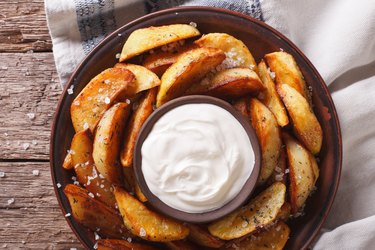
A sandwich graced with homemade mayo can transform a humdrum lunch into something special. You can also add herbs to your mayonnaise recipe to further boost the flavor. When making this condiment, it may sometimes turn out too thin, but don't despair because this one, simple technique will help.
Is Your Mayo Not Emulsifying?
Video of the Day
Lisa Richards, CNC, creator of the Candida Diet, tells LIVESTRONG.com how to fix this problem. First of all, though, you might be wondering how egg yolk acts as an emulsifier in mayonnaise. "Lecithin is a naturally occurring emulsifier, and egg yolks contain a fair amount of this phospholipid," Richards explains. "The term emulsifier means that it attracts both water and oil, thereby making the two able to blend together. This causes a mixing of the ingredients and allows thickening to occur."
Video of the Day
Is your homemade mayo too runny? "It's typically watery because it hasn't been blended enough to enable the emulsifier to do its job in bringing the water and oil together," Richards notes. "By mixing in a very small amount of boiling water, such as 2 teaspoons, the lecithin in the mayonnaise will be reactivated and enable it to accomplish its thickening effect."
"To thicken your mayonnaise, bring 2 teaspoons of water to a boil and whisk in the egg yolk," she adds. "As you whisk, begin adding in your already-prepared mayonnaise, and continue whisking until you reach your preferred thickness."
Basic Mayonnaise Recipe
Richards shares her mayonnaise recipe below. The Dijon mustard gives it a nice flavor. To further enhance the taste, you may include herbs or spices such as parsley, basil, chili powder or curry.
Ingredients:
- 1 egg yolk from a large egg, at room temperature
- 1 tablespoon lemon juice, at room temperature
- 1/2 teaspoon salt
- 1/2 teaspoon Dijon mustard, at room temperature
- 1/2 cup vegetable oil, at room temperature
- 1/4 cup olive oil, at room temperature
Directions:
- In a food processor, pulse the egg yolk and salt until combined.
- Add the Dijon mustard and lemon juice, and blend thoroughly.
- With the food processor still running, slowly add the oil. Start with the vegetable oil and then put in the olive oil. Do this slowly to prevent the mayo from separating. It should take at least two minutes.
- Cover the mayo and store it in the refrigerator. It should keep for at least three days.
Nutritional Information for 1 Tablespoon:
- Calories: 98
- Total fat: 11 grams
- Saturated fat: 1 gram
- Protein: None
- Carbohydrates: None
- Sodium: 70 milligrams
Homemade Mayonnaise Safety
The raw eggs in homemade mayonnaise may harbor bacteria called Salmonella, warns the Centers for Disease Control and Prevention. Salmonella can cause a foodborne illness that poses more danger for young children, older people and those with weakened immunity such as those with diabetes or HIV/AIDS. Symptoms include fever, vomiting and diarrhea.
Safety tips for eggs include buying them only from stores that have them in a refrigerated case, states the Food and Drug Administration (FDA). Before putting them in your shopping cart, open the carton and make sure the eggs are clean and free of cracks. Store them in a refrigerator set to 40 degrees Fahrenheit or below.
To be sure your homemade mayonnaise is safe, the FDA advises the use of pasteurized eggs in the recipe. This type of egg can be difficult to find, but some supermarkets carry them. In addition, include an acid like vinegar or lemon juice in your recipe because it will help prevent the growth of pathogens such as salmonella, recommends North Carolina State University.
- The Candida Diet: "About Us"
- Centers for Disease Control and Prevention: "Salmonella and Eggs"
- Food and Drug Administration: "What You Need to Know About Egg Safety"
- Food and Drug Administration: "Dairy and Eggs From Food Safety for Moms to Be"
- North Carolina State University: "It’s Not the Mayonnaise: Food Safety Myths & Summertime Food"